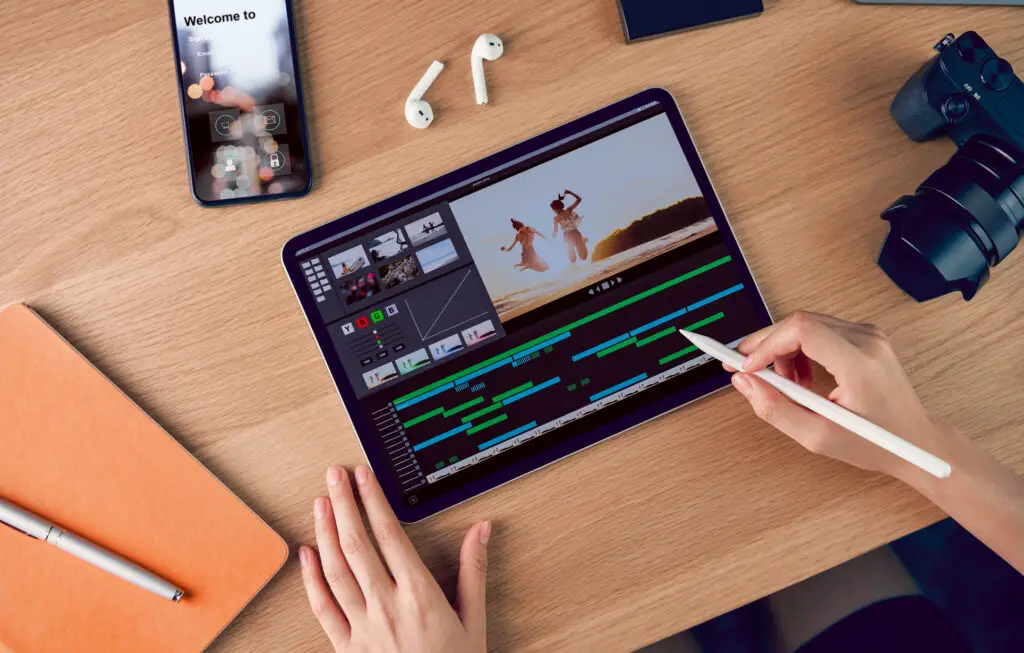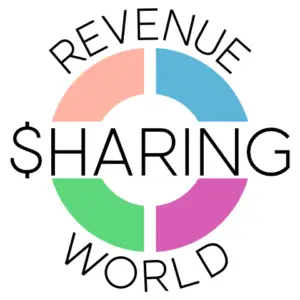Are you eager to delve into affiliate marketing, but intimidated by the idea of making videos? Fact is, billions are earned every year by those who choose to remain behind-the-scenes.
This article will guide you through several tried-and-true strategies for successful affiliate marketing without ever needing to press record. Let’s get started – your faceless fortune awaits!
Key Takeaways
- Affiliate marketing can be done successfully without making videos.
- Strategies such as blogging, social media, podcasting, growing an email list, and pay-per-click marketing can be used instead of videos.
- Non – video affiliate marketing offers advantages like privacy, lower costs, and the ability to remain anonymous.
- There are also disadvantages to non – video affiliate marketing, such as limited connection with the audience and the need for strong writing skills.
What is Affiliate Marketing?

Affiliate marketing is a way to make money online. You become a partner with a business and get paid for sending customers their way. As an affiliate marketer, you share product links on your website or blog.
When someone clicks on your link and buys from the merchant’s page, you earn money. This cash reward can be based on many things like clicks, purchases, or leads made from your promotion work.
It’s how some people make billions of dollars each year without ever showing their face! For example, Outdoor Gear Lab and Gadget Review are niche websites that make big bucks in this way.
It doesn’t always need videos either! There are lots of ways to do affiliate marketing without making videos which we will discuss later in this guide.
Can You Do Affiliate Marketing Without Making Videos?

Yes, you can do affiliate marketing without making videos. Many successful marketers earn money this way. They use other methods to share product links and ads. For example, they might write blog posts or send emails.
Starting a blog is an easy way to begin. You just need a topic you like and a website host. Websites like WordPress are good for beginners because they’re not hard to use.
Social media is another great tool for affiliate marketing without videos. Platforms like Facebook and Twitter let you share content with lots of people at once. With the right kind of post, your audience may want to learn more about what you’re promoting.
Also, think about starting a podcast if you feel comfortable speaking but don’t want to appear on video. People enjoy listening while doing other tasks, so podcasts are very popular now.
Email lists can help as well because it’s cheap and easy to send messages this way. An email list lets you reach many people fast too!
Lastly, Pay-Per-Click Marketing (PPC) is worth considering even though it costs money upfront – remember the goal is boosting traffic quickly!
How to Start Affiliate Marketing Without Videos

Learn various strategies for starting affiliate marketing without videos, such as starting a blog or website, using social media platforms, creating a podcast, growing an email list, and implementing pay-per-click marketing.
Discover new ways to promote products and earn income with affiliate marketing! Read More.
Starting a Blog or Website
You can start affiliate marketing by making a blog or website. Here are some steps to help you:
- Pick a good name for your blog or website. It should be easy to say and remember.
- Buy the domain name. This is the address where your blog or website will live on the internet.
- Get a hosting plan for your site. This is like renting space on the web.
- Install WordPress on your site. It’s a free tool that helps you make and manage your site.
- Choose a theme for your site. This will set how it looks to visitors.
- Make pages for your site, like an “About” page and a “Contact” page.
- Start writing blog posts about things in your niche.
Using Social Media Platforms
Using social media can boost your affiliate work. Let’s check out how to do it:
- First, pick the right platform. Find where your target audience hangs out most.
- Next, create an account. Make sure to appear professional and engaging.
- Start sharing content related to your niche. This can include text, photos, or even simple graphics.
- Add your affiliate links in posts or bio sections. You want your followers to click on them!
- Hold contests or giveaways to get more attention. Followers love free stuff.
- Keep close track of what works and what doesn’t. Improve by learning from each post.
- Also, link cloaking stops people from stealing your hard work. It hides your ID from the URL of your affiliate link.
Creating a Podcast
To promote affiliate marketing without making videos, you can create a podcast. Here’s how:
- Choose a topic: Select a niche that aligns with your interests and target audience.
- Plan your content: Outline episodes, decide on the format (interviews, solo episodes, etc.), and create a schedule.
- Set up recording equipment: Invest in a USB microphone and use editing software like Audacity or GarageBand.
- Create engaging content: Share valuable insights, tips, and recommendations related to your niche. Mention affiliate products organically within episodes.
- Publish and distribute: Upload your podcast episodes to platforms like Apple Podcasts, Spotify, and Google Podcasts.
- Promote your podcast: Use social media platforms like Twitter and YouTube to share new episode releases and engage with listeners.
- Drive traffic to your website: Mention your affiliate website or blog during podcast episodes and provide links in the show notes.
Growing an Email List
Building an email list is an important strategy in affiliate marketing. It helps you reach a targeted audience and promote your affiliate offers without making videos. Here are some ways to grow your email list:
- Offer a valuable freebie: Create a useful and relevant resource, such as an ebook or checklist, that your target audience would be interested in. Offer it as a free download in exchange for their email address.
- Create compelling opt-in forms: Place opt-in forms on your website or blog where visitors can easily enter their email addresses. Use attention-grabbing headlines and clear call-to-actions to encourage sign-ups.
- Utilize social media: Use social media platforms like Twitter to direct traffic to your landing page or opt-in form. Engage with your followers and promote the benefits of joining your email list.
- Collaborate with other marketers: Partner with other affiliate marketers or influencers who have a similar target audience. Offer exclusive discounts or bonuses to their followers in exchange for promoting your email list.
- Run contests or giveaways: Hold contests or giveaways where participants need to provide their email address to enter. This can help generate excitement and attract new subscribers.
- Provide valuable content: Regularly send out emails with valuable content, such as tips, tutorials, or exclusive offers, to keep subscribers engaged and encourage them to stay on your list.
Pay-Per-Click Marketing (PPC)
Pay-Per-Click Marketing (PPC) is a way to do affiliate marketing without making videos. Here are some important facts to know:
- PPC requires competition and constant optimization.
- Billions of dollars are earned annually through PPC in affiliate marketing without making videos.
- Building a WordPress affiliate website for PPC can cost less than $50 per year.
- Blogging and building niche websites are common starting points for successful PPC affiliate marketers.
- Social media platforms like Twitter provide opportunities for PPC affiliate marketing.
- YouTube and podcasting can be used for PPC affiliate marketing without showing your face or creating videos.
Pros and Cons of Affiliate Marketing Without Videos

Non-video affiliate marketing offers several advantages, such as broader reach and lower production costs. However, it also has its downsides, including limited engagement and potential for ad fatigue.
Discover the pros and cons of this approach to affiliate marketing in order to make an informed decision about your strategy. Keep reading to find out more!
Advantages of Non-Video Affiliate Marketing
Non-video affiliate marketing offers several advantages for beginner marketers. First, it allows you to earn a substantial income without revealing your face or personal information.
This means you can maintain your privacy while still making money online. Second, non-video marketing methods like blogging and niche websites are affordable to start and require minimal investment.
You can build a WordPress affiliate website for less than $50 per year. Lastly, by using pseudonyms or brand names, you can remain anonymous and create a trustworthy online profile without showing your identity.
Disadvantages of Non-Video Affiliate Marketing
Non-video affiliate marketing has its fair share of disadvantages. One major drawback is that without videos, it can be harder to build trust and connect with your audience. Videos allow viewers to see and hear you, which helps create a personal connection.
Without this visual element, it may take longer to gain the trust of potential customers.
Another disadvantage is that non-video affiliate marketing requires strong writing skills. You need to be able to effectively convey information and make persuasive arguments through your written content.
If writing isn’t your strong suit, this can be a challenge.
Additionally, non-video affiliate marketing may also require more time and effort in terms of creating quality content. Writing blog posts or articles takes time and research to ensure you’re providing valuable information for your audience.
Ways to Make Money with Affiliate Marketing Without Making Videos
Discover various methods to generate income through affiliate marketing without the need for creating videos. Explore content publishing platforms, guest posting on high traffic websites, leveraging social media platforms, and more.
Read on to learn how you can maximize your earning potential as an affiliate marketer without relying on video content.
Using Content Publishing Platforms
Content publishing platforms like Medium can be a great way to promote affiliate products without the need for making videos. Here are some benefits of using these platforms:
- Wide reach: Content publishing platforms have a large user base, which means your content can potentially reach a wide audience.
- SEO advantages: These platforms often have high domain authority, which can help boost your search engine rankings and bring in more organic traffic.
- Built-in audience: Many content publishing platforms already have an established community of readers who are actively looking for informative and engaging content.
- Easy monetization: Some platforms allow you to monetize your articles by including affiliate links or ads, giving you the opportunity to earn passive income.
- Establishing credibility: By regularly publishing quality content on these platforms, you can position yourself as an expert in your niche and build trust with your audience.
- Repurposing content: You can repurpose existing blog posts or articles on these platforms, saving you time and effort in creating new content.
Creating an Ebook
Creating an Ebook can be a unique and effective way to promote affiliate products without making videos. Here are some steps to get started:
- Choose a topic: Select a topic that aligns with your niche and has the potential to attract your target audience.
- Research and gather information: Conduct thorough research on your chosen topic to gather relevant information. Use credible sources and ensure the accuracy of the content.
- Organize the content: Create an outline for your Ebook to organize the information in a logical order. This will help you provide valuable insights to your readers.
- Write engaging content: Start writing each section of your Ebook, using clear and concise language that is easy for your audience to understand. Include useful tips, practical advice, or personal experiences to make it more relatable.
- Add visuals: Incorporate images, charts, infographics, or graphs if they enhance the understanding of your content. Visuals can make your Ebook more visually appealing and engaging.
- Design an attractive layout: Pay attention to the overall design and formatting of your Ebook. Use fonts, headings, subheadings, bullet points, and other formatting elements to make it visually pleasing and easy to read.
- Proofread and edit: Review your Ebook for grammatical errors, spelling mistakes, or any inconsistencies in tone or style. Ensure that it flows smoothly from one section to another.
- Create a compelling cover: Design an eye-catching cover that reflects the essence of your Ebook. This will attract readers’ attention and encourage them to download or purchase it.
- Finalize publishing method: Decide whether you want to self-publish it as a PDF on platforms like Amazon Kindle Direct Publishing or create a downloadable file on your website.
- Promote your Ebook: Once you have published your Ebook, promote it through various channels such as social media, email marketing, guest blogging opportunities, or partnering with influencers in your niche.
Guest Posting on High Traffic Websites
Guest posting on high traffic websites is a great way to make money with affiliate marketing without creating videos. Here are some key points to keep in mind:
- Look for popular websites in your niche that accept guest posts. These sites have a large audience and can help you reach more people.
- Write high – quality, informative content that provides value to the readers. This will increase the chances of your guest post being accepted.
- Include relevant affiliate links within your guest post. When readers click on these links and make a purchase, you earn a commission.
- Focus on building relationships with website owners and editors. This can lead to more opportunities for guest posting in the future.
- Track your results to see which guest posts are driving the most traffic and conversions. This will help you refine your strategy and focus on sites that yield the best results.
Posting on Online Communities and Forums
Posting on online communities and forums is a great way to do affiliate marketing without making videos. Here are some reasons why:
- Reach a targeted audience: Online communities and forums attract people who have a specific interest or problem. By participating in these communities, you can connect with your target audience and promote relevant affiliate products.
- Establish yourself as an expert: By sharing valuable information and advice on forums, you can position yourself as an authority in your niche. This builds trust with the community members, making them more likely to click on your affiliate links.
- Drive organic traffic: When you post helpful content on forums, it gets indexed by search engines like Google. This means that people searching for information related to your niche may come across your forum posts, leading to organic traffic to your affiliate links.
- Engage directly with potential customers: Forums allow for direct interactions with potential customers. You can answer their questions, address their concerns, and provide personalized recommendations for affiliate products that solve their problems.
- Leverage user-generated content: Many online communities and forums have sections where members share their experiences and reviews of products they’ve used. This user-generated content can be a powerful tool to promote affiliate products effectively.
Retargeting Strategies
Retargeting strategies are important for making money with affiliate marketing without creating videos. Here are some effective retargeting strategies to consider:
- Use Facebook Pixel: Install the Facebook Pixel on your website to track visitors and create customized ads for them on Facebook and Instagram.
- Set up Google Remarketing: Implement Google Remarketing tags on your website to show targeted ads to previous visitors when they are browsing other sites within the Google Display Network.
- Email Retargeting: Create personalized email campaigns targeting users who have shown interest in specific products or services on your website but didn’t convert into sales.
- Dynamic Product Ads: Display ads that feature products or services that were previously viewed by users on your website, helping remind them of their interest and encouraging them to make a purchase.
- Advertise Discounts or Promotions: Show retargeted ads with exclusive offers or discounts to entice customers to return and complete their purchase.
Leveraging Social Media Platforms
Social media platforms can be a powerful tool for affiliate marketers. Here are some ways you can leverage them to boost your affiliate income:
- Create engaging posts: Share interesting content related to your niche and include affiliate links in your posts.
- Join relevant groups: Find groups that cater to your target audience and actively participate by providing valuable insights and recommendations.
- Collaborate with influencers: Partner with social media influencers who have a large following in your niche. They can help promote your affiliate products to their audience.
- Run paid ads: Use the targeting capabilities of social media platforms to reach potential customers who are most likely to be interested in the products you’re promoting.
- Engage with your audience: Respond to comments, address concerns, and provide helpful information to build trust with your followers.
- Utilize visual content: Use eye-catching images, infographics, and videos to capture the attention of social media users and drive them to click on your affiliate links.
- Test different platforms: Experiment with different social media platforms like Instagram, Facebook, Twitter, or Pinterest to find out which ones work best for your niche.
Email Marketing
Email marketing is an effective way to do affiliate marketing without making videos. Here are some reasons why:
- Email marketing can be done without a website.
- It is a popular option for faceless affiliate marketers.
- Monetization strategies for email marketing include mixing in relevant affiliate offers, selling premium subscriptions, and selling digital products.
How to Choose Your Affiliate Niche
Choosing the right affiliate niche is crucial for your success as an affiliate marketer. You want to focus on a niche that has high demand and profitability. To choose your niche, consider your interests, knowledge, and passion.
Think about what topics or products you are genuinely interested in and have knowledge about. This will make it easier for you to create valuable content and engage with your audience.
Research profitable niches using tools like Google Trends or Amazon’s Best Sellers list to see what people are searching for or buying. Look for niches that have a good balance of competition and potential earnings.
It’s also important to consider the longevity of the niche – choose something that will remain relevant in the long term. Remember, choosing the right affiliate niche sets the foundation for your success in affiliate marketing.
Tips to Boost Your Affiliate Income Without Videos
- Focus on creating high – quality content that resonates with your target audience.
- Optimize your website or blog for search engines to drive organic traffic.
- Leverage social media platforms to promote your affiliate links and engage with your audience.
- Offer valuable free resources, such as ebooks or guides, to attract and retain visitors.
- Collaborate with other bloggers or influencers in your niche to expand your reach and attract new followers.
- Use email marketing to build a loyal subscriber base and nurture relationships with your audience.
- Experiment with different monetization strategies, such as sponsored posts or product reviews.
- Continuously track and analyze the performance of your affiliate links to optimize conversions.
Conclusion
In conclusion, affiliate marketing without making videos is absolutely possible. Building a successful affiliate income can be achieved through blogging, social media platforms, podcasting, growing an email list, and using pay-per-click marketing.
While there are advantages and disadvantages to non-video affiliate marketing, it offers various ways to make money such as using content publishing platforms, creating ebooks, guest posting on high traffic websites, leveraging social media platforms, and utilizing email marketing.
With the right strategies and niche selection, anyone can succeed in affiliate marketing without relying on videos.
FAQs
1. Can I do affiliate marketing without making videos?
Yes, you can! You don’t need to make videos for affiliate marketing. You can write reviews or blog posts about a product and link it to the merchant’s product page.
2. What skills do I need for this kind of affiliate marketing?
You need good internet research skills, networking skills, and the ability to select profitable niches using online tools. Content writing services also help in creating quality content-first affiliate sites.
3. How can I promote products without videos?
There are many ways for promotion online. Using SEO tactics such as Google Search traffic or organic traffic strategy is effective! Social platforms offer another way to reach out and promote your chosen products.
4. Can I earn money from this type of affiliate marketing?
Yes! By leading internet users from your content towards purchase on the Merchant’s product page helps in Cost-Per-Acquisition (CPA). This means that with each purchase made from their click on your site; you get earnings!
5.Never did video making before but want to try some easy methods – any advice?
Screen casting, voiceovers and mashups are great places to start if you wish to step into video production; yet maintain simplicity.
6.Does everyone who does Affiliate Marketing have their own websites?
While majority use website building techniques for hosting content and links; one could also start a blog, build an email list or explore social media platforms as alternatives!


